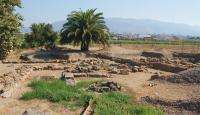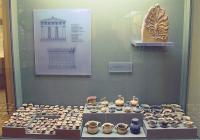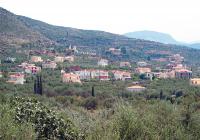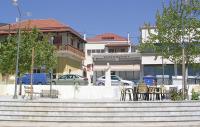 The
Akovitika
archaeological
site Various departments of the city of Kalamata located on and around the road network connecting Kalamata to the rest of Messinia (to the west) have experienced a rapid pace of development over the past few years. Due to their proximity to the city, these areas are mostly urban in character. The local technical college and hospital are also located here. Taking a left (south) off the main road brings us to Akovitika, an important archaeological site where excavations have revealed remnants believed to have been the Sanctuary of Poseidon and the foundations of an early Helladic palace. From the Temple of Poseidon, archaeologists have dug up the northern side of a rectangular structure with an atrium in the middle surrounded by a Doric - columned arcade. A long, narrow corridor with wooden columns enclosed the arcades from the exterior. A small well made of limestone was found in the interior. The building is dated to the 6th century BC, while there is also evidence of an earlier phase of construction (late 7th century BC). Excavation finds (models of equipment from boats and ships as well as a bronze fish hook) have led scientists to believe that the sanctuary was built by sailors as tribute to the god of the sea, Poseidon, a fact confirmed by an inscription found on the side of a vase. The sanctuary is thought to have been located a few meters northeast of the rectangular building, in an area where various bronze votive statuettes (a sea horse, bulls and a horse) were found. The early Helladic palace, the only building in the Peloponnese from this period, is located 200 meters north of the Sanctuary of Poseidon. It was a colossal structure, measuring 35 meters in length. The foundations were constructed of stones taken from the river, cemented together with a hard mixture of clay and sand, while above ground the building was made of raw plinth. Loose finds are dated to the Protohelladic II (Early Bronze Age, 2800-2300 BC) period.  Findings from
the area of
Akovitika,
as they are
displayed in
Kalamata’s
Archaeological
Museum The palace is comprised of an antechamber, a large central chamber and a cobblestone corridor which led to a small courtyard at the western end of the building. There is small window made of slate in the western pilaster of the antechamber. The back of the building most probably contained storage areas and auxiliary rooms. The building was likely destroyed by flooding from the nearby Ari River, which continues to flow west of the palace. Continuing down the road brings us to Asprohoma, where it is worth stopping for a visit to the Church of Pammegiston Taxiarchon (the Major Archangels), an interesting example of Neoclassical-style architecture.  Τhe village of
Leika At the northwest of the road lies the village of Leika, which has old mines and quarries, as well as the Church of the Dormition of the Virgin (Kimisis tis Thotokou), which is dated to the 19th century but reconstructed later on. Sites of interest at Antikalamos, where the local hospital is located, include the Church of Aghios Georgios, an asceterion located in a small cave which contains traces of religious murals and the Church of Aghios Ioannis “Skrouberis,” a cavernous building with an astonishing number of murals in two layers, the second of which is dated to the 18th century. During the Turkish occupation, the church operated as a secret school where Greeks went to learn their language and religion, the teaching of which had been banned by Turks.  Sperhogeia Six kilometers from Kalamata and the road brings us to Sperhogeia, the technical college (TEI) and the Church of the Dormition of the Virgin. This is a single- vaulted church with three apses jutting out on the east. On the western side it is adjoined to a more recent open columned portico. The double- foiled window in the central apse confirms the church’s date for sometime between the 16th and 17th centuries. The sanctuary of Aghios Georgios (Saint George) is also located in this village.  Τhe
hospital in
Antikalamos |